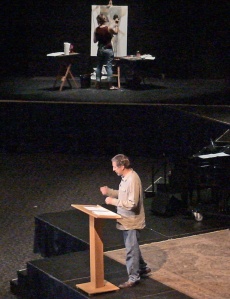Many churches are beginning to incorporate live painting into their worship services. For those who haven’t experienced this, a painter(s) will begin with a large, blank canvas at the beginning of a service and paint throughout the worship time, sometimes through the sermon and even through multiple services. The painter (or other visual artist) is considered a worship leader, and often stands alongside the other members of the worship team. The content of the painting is often related to the theme of the worship or message, and the painting is characterized by some sense of spontaneity, experimentation, discovery, and artistic virtuosity.
Oak Hills Church has been incorporating performance artists into our services for a number of years now, an extension of the Art & Soul Gallery which hangs in our church lobby. Beyond the superficial “cool factor,” there really is a theological and philosophical rationale undergirding this trend.
So I thought it would be helpful for those who have or are contemplating live painting to know the reasoning behind live painting. In other words: Why paint during a worship service?
 • Live painting is an act of creativity. And the act of creativity reminds us that we worship and are made in the image of an Eternally Creative God. Watching a painting take shape evokes a Bob Ross sense of wonderment and curiosity, two necessary characteristics of the growing worshiper.
• Live painting is an act of creativity. And the act of creativity reminds us that we worship and are made in the image of an Eternally Creative God. Watching a painting take shape evokes a Bob Ross sense of wonderment and curiosity, two necessary characteristics of the growing worshiper.
• Live painting is a non-verbal expression of the sermon. The Church has a long-established history of displaying paintings and sculpture and other visual means as aids to worship, but unfortunately some of our faith traditions walked away from much of this during the Reformation. Stained glass, as an example, was an art form that brilliantly and boldly preached the story of God to an illiterate laity. And although we generally have a literate population in this day and age, the visual arts still speaks boldly to the visual learner. At our church, a performance artist recently painted the Biblical figure, Abagail, in support of a message preached from 1 Samuel 25. It was quite effective.
• God meets us in the act of creation. The Holy Spirit is our Inspirer. He works not only through the artist to express each brush stroke, but also works through the audience to ascribe meaning to that colored canvas. If we truly believe that God speaks to us, then performance art gives us the opportunity to open the eyes of our hearts to Him. This is just as true with works of abstraction as well as of realism or metaphor.
• Art can be Prophetic. The artist of faith has the ability to tell the story of God, and share the heart of God, through means beyond mere words. Prophetic art has been defined as, “revealing by divine inspiration, to reveal the will or message of God, to illuminate or bring revelation to a situation.” When we let artists of faith express themselves in a service, we release a prophetic stream often untapped in many of our churches.
• Live painting is an expression of faith. Live painting gives the visual artists in our church a venue for publicly expressing their faith through non-musical worship. We strongly believe that the non-verbal testimony of those who paint is as important as the verbal testimonies we share in our services.
 Now that I’ve shared with you five reasons to incorporate live painting into your services, let me give you three quick reasons why you shouldn’t:
Now that I’ve shared with you five reasons to incorporate live painting into your services, let me give you three quick reasons why you shouldn’t:
• Because it sounds like it would be something cool. Please don’t do this because you saw something like it on “America’s Got Talent.” It is crucially important that expressions of the arts in your local church be premised by a foundational theology of the arts. In other words, what you do should spring from your beliefs, not from simple stylistic preferences.
• Because you’re trying to create a spectacle of some sort. Don’t use artists like so many side shows in a circus. Art is not the show before the sermon. The arts are, for artists of faith, an expression of life lived in Christ. Respect the arts and your artists—for who they are and not simply for what they do.
• Because Aunt Betty took a class in painting at the community college. As I’ve preached before, medium and message are inextricably entwined. And as such, we cannot settle for art that is simplistic, derivative, superficial, propaganda-driven, or mediocre, for it reflects on the message. And our message is that of God’s love through Jesus Christ. If the story of God is to shine from our work, and we must be diligent and committed to pursue excellence, originality, and honesty as we express it.
Do you have other thoughts? Is your church incorporating performance artists, and if so, do you have substantive reasons why? Let me know your thoughts.
[Photo Credits: [Top] Randy Blasquez interprets a view of the Lord’s Supper; [Middle] Anna Agundez sculpts two people in embrace (the flat screen to the right allows the audience to see her work in more detail); [Bottom] Melinda Word paints during the message given by Pastor Kent Carlson. Photos taken by Dave Kilborn.]

